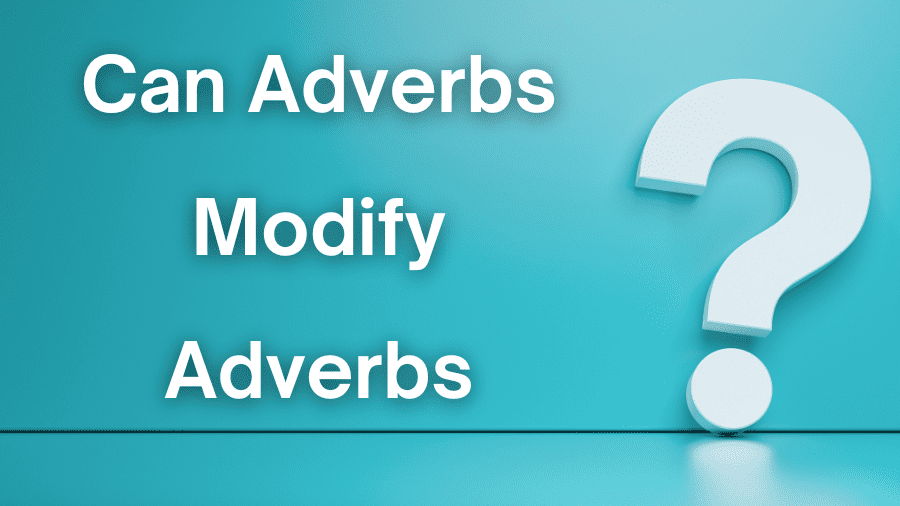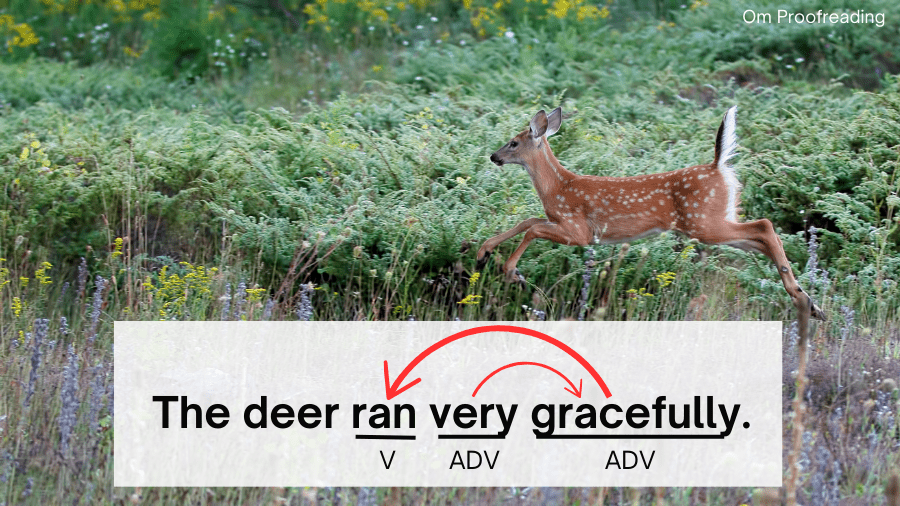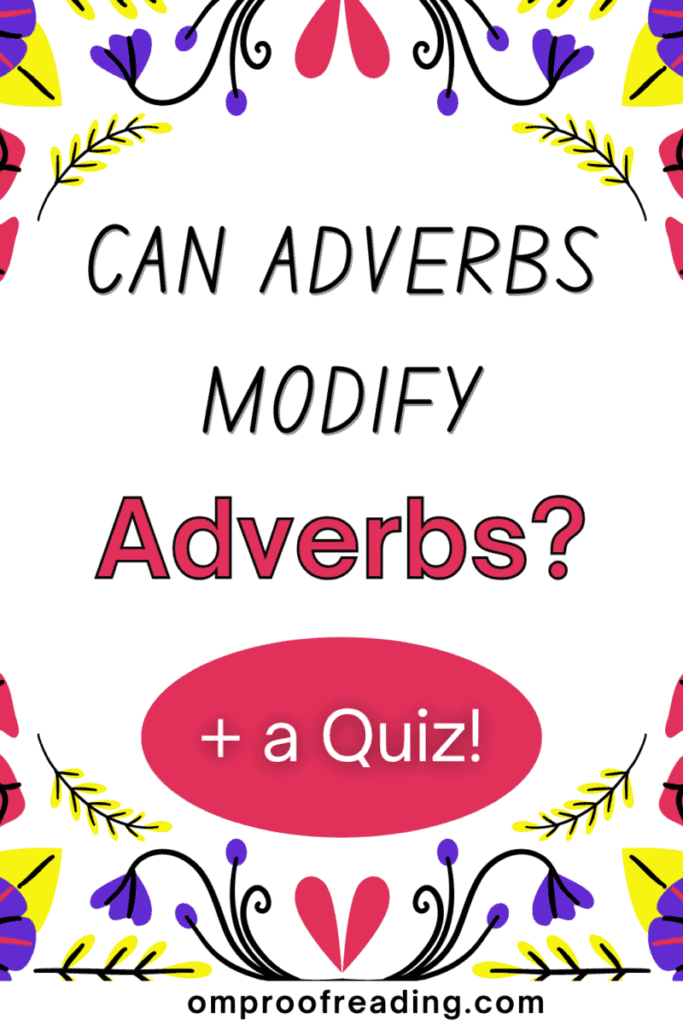This article may contain affiliate links. Please see our affiliate disclaimer in the footer menu for more information. Thank you for your support!

You may know that adverbs can modify (i.e., describe) verbs and adjectives, but can adverbs modify adverbs too? As a trained proofreader who has thoroughly studied the parts of speech, I can help you answer this question.
Adverbs can modify other adverbs. They usually answer the question how or to what extent (how often or how much) about the adverbs they describe. They tell us more about the degree to which an adverb modifies another adverb.
Adverbs that modify other adverbs make our speech and writing more precise by giving us additional information about an action or the quality of something. Thanks to adverbs, we can convey a message in a more accurate, clear, and engaging way.
Let’s see examples of adverbs modifying adverbs; then you can take a quiz to check your understanding.
What Are Adverbs?
Adverbs are one of the eight parts of speech that make up the English language.
Let’s see the parts of speech:
- nouns
- pronouns
- verbs
- adjectives
- adverbs
- prepositions
- conjunctions
- interjections
Here’s what the Cambridge Dictionary says about how we use adverbs:
“Adverbs are one of the four major word classes, along with nouns, verbs and adjectives. We use adverbs to add more information about a verb, an adjective, another adverb, a clause or a whole sentence and, less commonly, about a noun phrase.”
– the Cambridge Dictionary
Adverbs typically answer one of the following questions about the parts of speech they modify:
- How?
- When?
- Where?
- To what extent? (How often? or How much?)
If you’re curious whether a particular word is an adverb, figure out what part of speech it modifies and whether it answers one of the questions above.
Can Adverbs Modify Adverbs?
So the answer to our burning question is yes!—adverbs have the versatility and awesomeness to modify (i.e., describe) other adverbs. 😊
Let’s see two common ways in which this happens.
An Adverb Modifying an Adverb That Modifies a Verb

Sometimes an adverb modifies an adverb that’s modifying a verb.
We know that a verb is an action word.
And remember that adverbs answer the question how or to what extent (how often or how much) about the adverbs they modify.
Example Sentence: The deer ran very gracefully.
The adverb very modifies the adverb gracefully.
Explanation: Very tells us how gracefully the deer ran.
- How gracefully did the deer run? (very)
Gracefully is also an adverb.
The adverb gracefully modifies the verb ran.
When an adverb modifies a verb, it gives us more information about the action—how, when, where, or to what extent it happens.
Explanation: Gracefully tells us how the deer ran.
- How did the deer run? (gracefully)
The adverb very modifies the adverb gracefully, which modifies the verb ran.
An Adverb Modifying an Adverb That Modifies an Adjective

Now let’s see what it looks like when an adverb modifies an adverb that’s modifying an adjective.
We know that adjectives modify nouns and pronouns, and they typically tell us what kind, which one, or how many about the nouns and pronouns they modify.
We also know that adverbs answer the question how or to what extent (how often or how much) about the adverbs they modify.
Example Sentence: The mountains were almost completely covered with snow.
The adverb almost modifies the adverb completely.
Explanation: Almost tells us to what extent the mountains were completely covered.
- To what extent were the mountains completely covered? (almost)
Completely is also an adverb.
The adverb completely modifies the adjective covered.
(The adjective covered modifies the noun mountains.)
When an adverb modifies an adjective, it typically answers the question to what extent or how—just like when an adverb modifies an adverb.
Explanation: Completely tells us to what extent the mountains were covered.
- To what extent were the mountains covered? (completely)
The adverb almost modifies the adverb completely, which modifies the adjective covered.
More Examples of Adverbs Modifying Adverbs
Let’s jump into a few more example sentences so you can have a solid understanding of how adverbs do their thing when they modify other adverbs. 😉
All the sentences below follow an important rule about where we place adverbs that modify other adverbs.
Rule: Adverbs that modify other adverbs come right before the word they modify.
1) Example: The dog approached the kitten somewhat cautiously.
The adverb somewhat modifies the adverb cautiously.
Explanation: Somewhat tells us how cautiously the dog approached the kitten.
- How cautiously did the dog approach? (somewhat)
2) Example: The teacher listened quite patiently as the child spoke.
The adverb quite modifies the adverb patiently.
Explanation: Quite tells us how patiently the teacher listened to the child.
- How patiently did the teacher listen? (quite)
3) Example: John is always totally certain he’ll ace his math exam.
The adverb always modifies the adverb totally.
Explanation: Always tells us to what extent (how often) John is totally certain he’ll ace his math exam.
- How often is John totally certain? (always)
Before the quiz, let’s go over a few common questions.
Frequently Asked Questions

Can some adverbs modify entire sentences?
Some adverbs can modify entire sentences. Sentence adverbs, as they’re known, ordinarily come at the beginning of the sentences they modify. However, they can also come at the end or in the middle of sentences. Some examples of sentence adverbs are maybe, fortunately, clearly, and however.
Do adverbs usually come after the adverb they modify?
Adverbs that modify other adverbs come immediately before the word they modify. Adverbs that modify adjectives also come right before the word they modify.
What does an adjective modify?
An adjective modifies a noun or pronoun. A noun is a person, place, thing, or idea. A pronoun is a word that replaces a noun (e.g., it, he, they). An adjective answers the question what kind, which one, or how many concerning the noun or pronoun it describes.
Quiz: Adverbs Modifying Adverbs
Let’s make sure you understand what we’ve covered.
If you miss a quiz question, I’ll give you the correct answer with an explanation.
And if you don’t understand the explanation, this post on Om Proofreading will help you get a better grasp on adverbs: “How to Identify Adverbs: A Complete Guide (+ Quiz).”
Enjoy the quiz! 😊
Important: After finishing the quiz, please scroll back up the page and click the “View score” button.
I hope this article has thoroughly answered your question about whether adverbs can modify adverbs.
Best wishes to you!
“Make the most of what you have and keep your standards high. Never settle for anything less than you deserve or are capable of achieving.”
– Roy T. Bennett

Recent Posts
Punctuation is important because it enables us to communicate our message clearly and effectively. Without punctuation, we wouldn’t understand how units of a sentence relate to one another or how...
Although you're probably somewhat familiar with adverbs, you may be unaware of sentence adverbs. As a trained proofreader who has studied the parts of speech, I can help you understand this unique...
